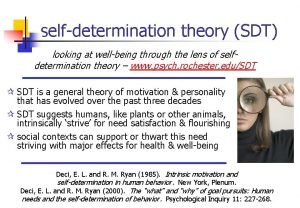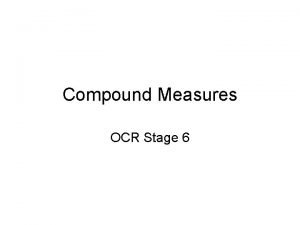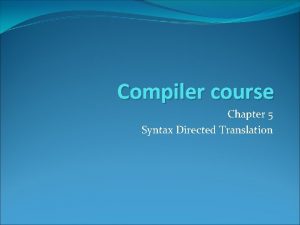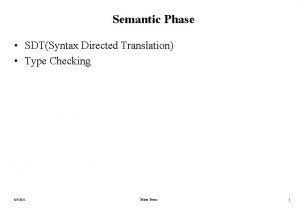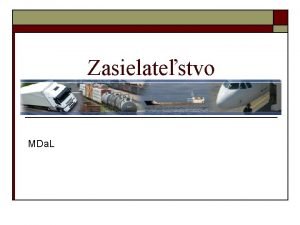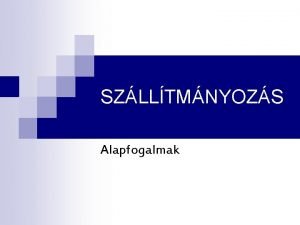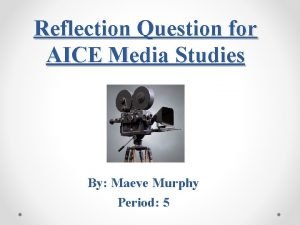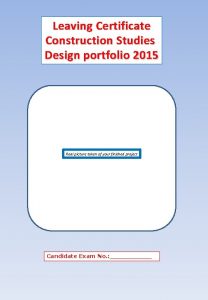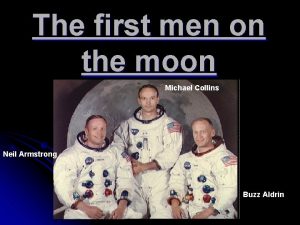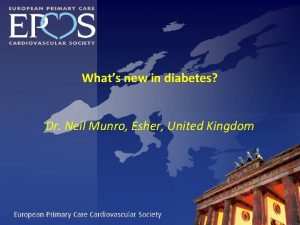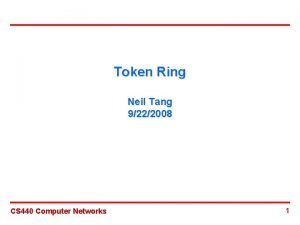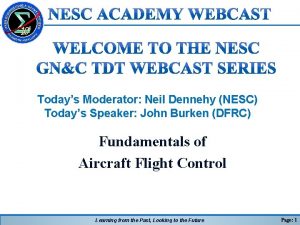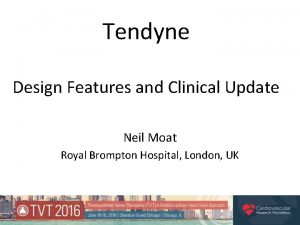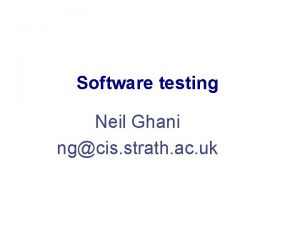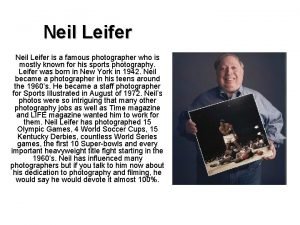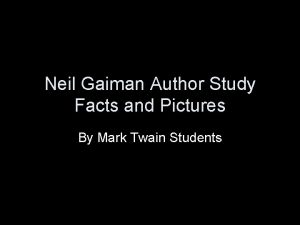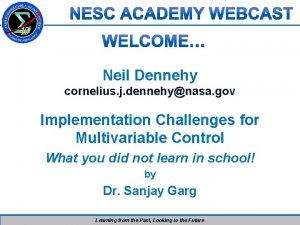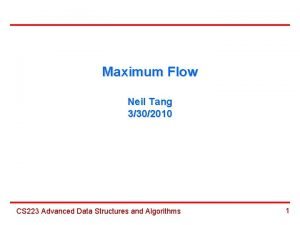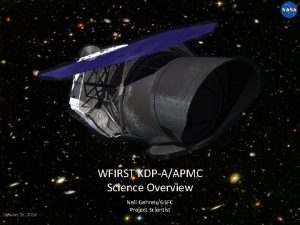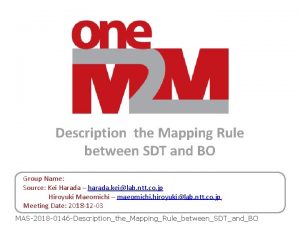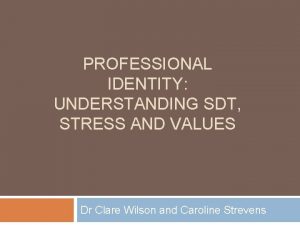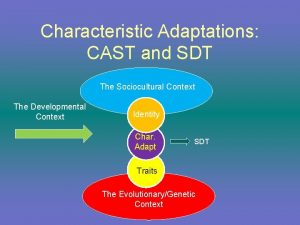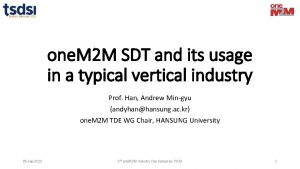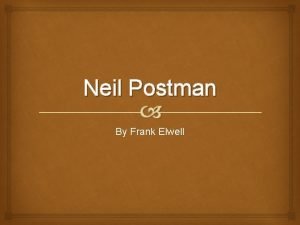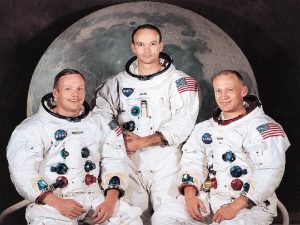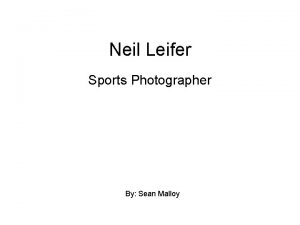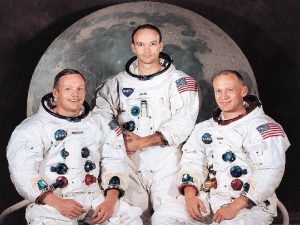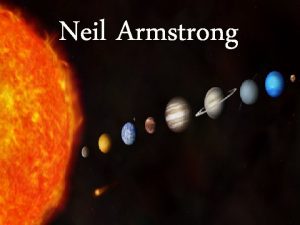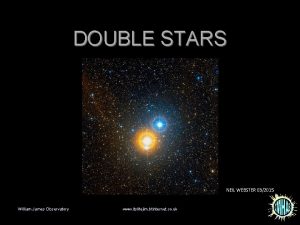WFIRST SDT and Project Studies Neil Gehrels WFIRST



























- Slides: 27

WFIRST SDT and Project Studies Neil Gehrels WFIRST Study Scientist Princeton Workshop September 4, 2012

WFIRST Summary v WFIRST is the highest ranked large space mission in NWNH, and plans to: - complete the statistical census of Galactic planetary systems using microlensing - determine the nature of the dark energy that is driving the current accelerating expansion of the universe - survey the NIR sky for the community - conduct a guest observer program v Measurements all require wide-field NIR observatory - NIR sky surveys for BAO and weak lensing and - NIR monitoring for SNe and exoplanets v Space-qualified large format Hg. Cd. Te detectors are US developed technology and flight ready H 4 RG Mosaic Plate H 2 RG EDU FPA

WFIRST Dark Energy Systematics Control for SNe Bright Ha line for BAO Atek+ '12 Kowalski+ '08 Galaxy Shapes in IR for WL Kocevsk+ '11

WFIRST Exoplanets WFIRST Kepler Figures from B. Mac. Intosh of the Exo. Planet Task Force

WFIRST NIR Surveys NIR Imaging Surveys NIR Redshift Surveys WFIRST-SN WFIRST provides a factor of 100 improvement in IR surveys

WFIRST Happenings Key Conclusions of the SDT • WFIRST created by NWNH EOS panel from JDEM (dark energy), MPF (exoplanet microlensing) and NIRSS (IR surveys) (JDEM Omega configuration, 1. 5 m telescope) • Science Definition Team (SDT) formed November 2010 Co-Chairs Jim Green & Paul Schechter • SDT interim report June 2011 (ar. Xiv 1108. 1374) (IDRM – off-axis telescope version of JDEM-Omega) • Discussion of using NRO telescope with 2. 4 m mirror • SDT final report August 2012 (DRM 1 & DRM 2 – off-axis telescopes, single instrument)

SDT original Charter The SDT Charter “The SDT is to provide science requirements, investigation approaches, key mission parameters, and any other scientific studies needed to support the definition of an optimized space mission concept satisfying the goals of the WFIRST mission as outlined by the Astro 2010 Decadal Survey. ” 2 nd Year - Complete detailed study of primary configuration - Create a second cheaper option that is complementary to Euclid, LSST and JWST - Augment SDT with 5 new members

WFIRST Science Definition Team Paul Schechter, MIT James Green, U. Colorado/CASA Co-Chair Rachel Bean, Cornell University Charles Baltay, Yale David Bennett, Univ. of Notre Dame Robert Brown, STSc. I Christopher Conselice, Univ. of Nottingham Megan Donahue, Michigan State Univ. Scott Gaudi, Ohio State Univ. Tod Lauer, NOAO Bob Nichol, Univ. of Portsmouth Saul Perlmutter, UC Berkeley / LBNL Bernard Rauscher, GSFC Jason Rhodes, JPL Thomas Roellig, Ames Daniel Stern, JPL Takahashi Sumi, Nagoya Univ. Angelle Tanner, Mississippi State Univ. Yun Wang, Univ. of Oklahoma Edward Wright, UCLA Neil Gehrels, GSFC Ex-Officio Wes Traub, JPL Ex-Officio Rita Sambruna, NASA HQ Ex-Officio New Members Jan. 2012 Xiaohui Fan, U. Arizona Chris Hirata, Caltech Jason Kalirai, STSc. I Nikhil Padmanabhan, Yale David Weinberg, Ohio State U. 8

H 4 RG-10 Mosaic Plate with WFIRST Science Definition Team, NASA HQ, and Project Office Team February 3, 2012

Requirements Flowdown • Substantiation that WFIRST can achieve NWNH science • Traces science requirements from top level objectives

Over 80 Concepts Developed

TMA Telescope • Three Mirror Anastigmatic • Unobscured (unocculted) design • Three powered (curved) mirrors • 9 degrees of freedom from mirrors (curvature, conic constant, position for each) • Allows control of 9 parameters (focal length, magnification of each mirror, astigmatism, coma, spherical aberration, field curvature) • Wider field than Ritchey-Chrétien • Better image quality than Schmidt

NIR Detectors • H 2 RG detectors - • H >> HAWAII = Hg. Cd. Te Astron. Wide Area IR Imager 2 >> 2048 x 2048 pixels R >> reference rows & columns to correct bias fluctuations G >> guiding function, selectable window for guide star Space H 1 Rs used on HST. Sensor Chip Assembly Space H 2 RGs developed for JWST • Goals of WFIRST program - Larger mosaics than JWST Silicon carbide support structure H 4 RG development GSFC SI Carbide mount

Design Reference Missions q IDRM § § q 1. 3 meter off-axis telescope 3 -channel payload 5 year mission Atlas V Launch Vehicle DRM 1 § § q 1. 3 meter off-axis telescope Single channel payload 5 year mission Atlas V Launch Vehicle DRM 2 § 1. 1 meter off-axis telescope § Single channel payload § 3 year mission § Falcon 9 Launch Vehicle

Design Reference Missions q IDRM § § q 1. 3 meter off-axis telescope 3 -channel payload 5 year mission Atlas V Launch Vehicle DRM 1 § § q 1. 3 meter off-axis telescope Single channel payload 5 year mission Atlas V Launch Vehicle DRM 2 § 1. 1 meter off-axis telescope § Single channel payload § 3 year mission § Falcon 9 Launch Vehicle

WFIRST DRM 1 Payload Optics Block Diagram Telescope 180 mas/pix ~205 K Unobstructed, Focal Telescope: 1. 3 m Aperture PM and SM followed by Tertiary Mirror (TM) and fold flats that feed the science channel and an auxiliary FGS Instrument TM 180 mas/pix f/15. 9 Cold Pupil Mask Filter Wheel 8 positions (6 filters, open, blank) Prism Wheel 6 positions (3 prism assemblies, {SN, 2 GRS}, 3 open) “Outrigger FGS” SCAs (4, in pink) shown in notional positions on Focal Plane 9 x 4 FPA; 2 kx 2 k. 18 μm SCAs; 150 Mpix; 100 K; 0. 6 -2. 4µm bandpass; 0. 375 deg 2 Active Area Science Channel SN Resolving power 75/2 pixel; GRS Dispersion DQ= 160 -240 arcsec Auxiliary FGS 250 mas/pix; f/11. 4 1 x 2 FPA; 2 kx 2 k, 18μm pixel size SCAs; ~8 Mpix; <120 K; 0. 6 -2. 0µ bandpass; 0. 04 deg 2 Active Area 0. 30° x 0. 14° FOV Extent GRS = Galaxy Redshift Survey FGS = Fine Guidance Sensor: Outrigger FGS used during imaging, Auxiliary FGS used during spectroscopy SN = Type 1 a Supernovae

DRM 1 Field of view & focal plane layout H 2 RG detectors WFIRST-JWST Focal plane Comparison • Area is 145 x larger than NIRCAM (0. 375 vs. 0. 00259 sq degrees • Focal plane has 5 x more pixels than NIRCAM short wave cameras (150 vs 33 Mpix)

CANDELS fields on DRM 1 focal plane from J. Kruk

DRM 2 Field of view & focal plane layout H 4 RG detectors WFIRST-JWST Focal plane Comparison • Area is 226 x larger than NIRCAM (0. 585 sq vs 0. 00259 degrees) • Focal plane has 7 x more pixels than NIRCAM short wave cameras (235 vs 33 Mpix)

WFIRST DRM 1 Observatory Layout & Ray Trace FPA SM radiator GRS prism F 2 F 1 PM Solar array/sunshield Spacecraft TM

WFIRST DRM 2 Observatory Layout Solar array(blue) & sunshade Launch configuration FPA Instrument Telescope • Sun at bottom • WMAP-like Radiator progression from warm solar array (300 K) to cold focal plane (100 K) from bottom to top • Overall dry mass 500+ kg less than DRM 1 Spacecraft Solar array(blue) & sunshade, deployed

Survey Strategies Example DRM 1 Observing Plan Sun angle (deg) HL Survey WL & BAO SNe GPS GO Program exoplanets Time (months) from C. Hirata

DRM 1 Performance Exoplanets: >2000 bound exoplanets of 0. 1 – 10, 000 Earth mass (MEarth) >30 free floating planets of 1 MEarth 200 terrestrial planets* (0. 3 – 3 MEarth) Accelerating Universe: WL and BAO surveys of >1400 deg 2 per year to a Hα line spectroscopy limit of 1 × 10− 16 ergs/cm 2/sec and imaging limit of AB=26. SNe-Ia: 2 tiered survey covering 6 deg 2 and 2 deg 2 with a five day cadence over 1. 8 years yielding ~100 SNe per ∆z = 0. 1 bin NIR Surveys: 2000 quasars at redshift z > 7 and 35 quasars at redshift > 10 Broad-band NIR spectral energy distributions of 3 X 109 galaxies Map of Galaxy structure using red giant clump stars as tracers

WFIRST DRM 1 Schedule Estimate • 79 month development schedule • • • Start of Phase B FY 15 Launch Readiness Date Sept ember 2020 7 month schedule reserve Funded Schedule Reserve

Cost Estimates • The WFIRST Independent Cost Estimate by Astro 2010 (based on JDEM configuration) was $1. 6 B • The Project Office cost estimates indicate that DRM 1 would have a full cost less that $1. 6 B due to single instrument channel and reduced mass. • The Independent Cost Estimate for DRM 2 is $1. 1 B

Conclusions • The SDT and Project have completed the action of developing two compelling mission concepts. • DRM 1: Fully responsive to the objectives of NWNH at reduced cost • DRM 2: Capable low-cost near-infrared survey opportunity. The limited 3 year life precludes full compliance with NWNH goals. • Path forward: • Study WFIRST mission utilizing NRO telescope with new SDT • Develop 4 kx 4 k IR detectors for wide-field applications

 Sdt theorie
Sdt theorie Identified motivation
Identified motivation S=d/t triangle
S=d/t triangle Evaluation orders for sdd's
Evaluation orders for sdd's Sdt for type checking
Sdt for type checking Sdt ultrasound
Sdt ultrasound Fiata fwr
Fiata fwr Fiata okmányok
Fiata okmányok Paradigm shift from women studies to gender studies
Paradigm shift from women studies to gender studies Aice media studies final project
Aice media studies final project Construction portfolio leaving cert example
Construction portfolio leaving cert example Project topic on social studies
Project topic on social studies Michael collins buzz aldrin and neil armstrong
Michael collins buzz aldrin and neil armstrong Dr neil munro
Dr neil munro Neil tang
Neil tang Neil dennehy
Neil dennehy Moat house surgery
Moat house surgery Neil ghani
Neil ghani Neil mooser reaction positive in
Neil mooser reaction positive in Neil farrington
Neil farrington Neil borden
Neil borden Neil leifer biography
Neil leifer biography Neil gaiman facts
Neil gaiman facts Cornelius dennehy
Cornelius dennehy Neil armstrong character traits
Neil armstrong character traits My weird school all books
My weird school all books Cs
Cs Block qc
Block qc
